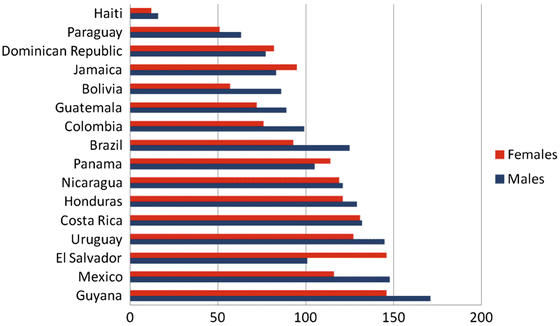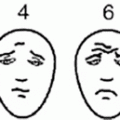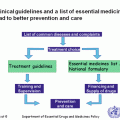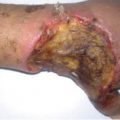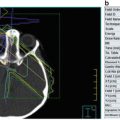Fig. 2.1
Lowest and highest age-standardized incidence rates for all childhood cancers, LMIC from Africa (Source: GLOBOCAN 2008).
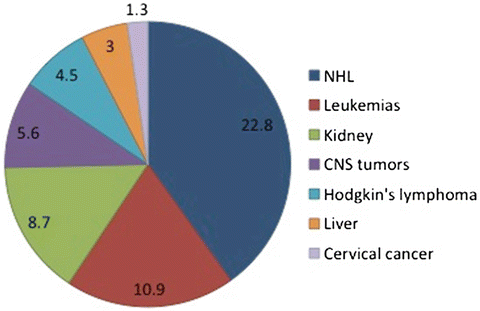
Fig. 2.2
Most frequent cancer types (%) among children 0-14 years in LMIC, Africa (Source: GLOBOCAN 2008).
In Africa, HIV infection is an important cause of childhood cancer. Studies have shown an excess of Kaposi sarcoma and Burkitt lymphoma among HIV-infected children [10–12]. On the other hand, leiomyosarcoma, which is frequently reported among HIV-positive children living in developed countries, is rarely reported in African countries [12]. Of interest, cervical cancer is the seventh most common cancer diagnosis in children less than 14 years of age, probably a reflection of the widespread infection with virulent forms of human papilloma virus as well as the underlying susceptibility due to HIV. Liver cancer is one of the most common cancers in Africa as well, likely due to high prevalence of hepatitis B.
Overall, mortality rates for the group of LMIC from Africa are 80 and 57/million for all cancers for males and females, respectively, ranging from 36 (Cote d’Ivoire) to 189/million (Malawi) for males and between 23 (Guinea) and 111/million (Uganda) for females (Fig. 2.3).
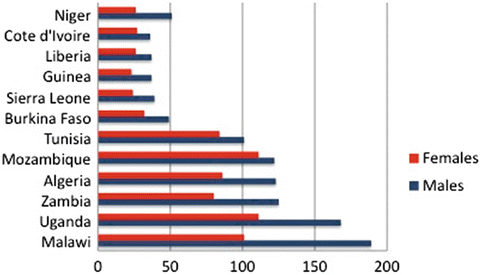

Fig. 2.3
Lowest and highest age-standardized mortality rates for all childhood cancers, LMIC from Africa (Source: GLOBOCAN 2008).
Trends in Childhood Cancer Mortality in LMIC from Africa
According to data available in the WHO Mortality Database, it is possible to obtain a continuous series to assess trends in mortality for only two LMIC from Africa: Egypt (2000–2010) and South Africa (1993–2009). In South Africa, no significant trends were observed in childhood cancer mortality for males (APC = 1.2, 95 % CI −0.1; 2.5), while an increase was observed among females (APC = 1.4, 95 % CI 0.4–2.4). In Egypt, no important changes were observed for both sexes (males, AAPC = 1.2, 95 % CI −3.1; 5.7; females, AAPC = 2.9; 95 % CI −0.2; 6.1).
Childhood Cancer in LMIC from Asia
According to GLOBOCAN estimated incidence of all pediatric cancers (0–14 years) in LMIC from Asia is 96 and 77/million for males and females, respectively. There is a wide variation in rates, with the highest rates being recorded in Kazakhstan (198/million for males) and Sri Lanka (161/million among females), while the lowest incidence rates are observed in North Korea and Tajikistan (51/million among males and females) (Fig. 2.4). Leukemia is the most frequent cancer type, corresponding to more than one third (35.7 %) of all cancers diagnosed in children living in LMIC from Asia, followed by CNS tumors (12.4 %) and non-Hodgkin lymphomas (7.4 %) for both sexes (Fig. 2.5).
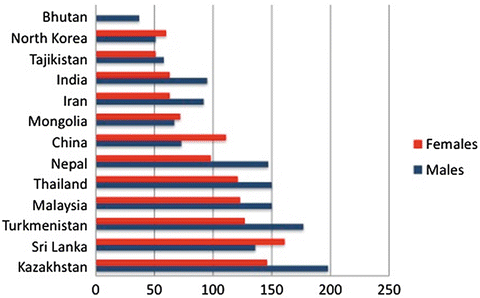
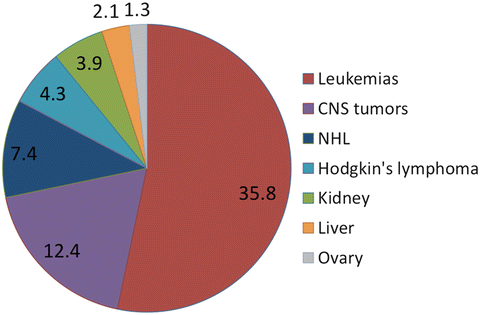

Fig. 2.4
Lowest and highest age-standardized incidence rates for all childhood cancers, LMIC from Asia (Source: GLOBOCAN 2008).

Fig. 2.5
Most frequent cancer types (%) among children 0-14 years in LMIC, Asia (Source: GLOBOCAN 2008).
Of note, ovarian tumors account for 3.2 % of all pediatric tumors among females, with an age-adjusted incidence rate in the region of 2 new cases/million/year. This is higher than observed in other regions of the world. Liver cancers still remain as one of the most frequent tumor types, for both males (sixth more frequent) and females (seventh more frequent), with incidence rates of 2 and 1/million/year, respectively. Vietnam has the second highest incidence and mortality rates of liver cancer worldwide (ASIR = 10/million; ASMR = 4/million/year). The association of hepatitis B virus (HBV) infection and liver cancer is well documented in epidemiological studies. The introduction of universal HBV vaccination program for the newborn in endemic regions has started to show a beneficial impact [13]. Vietnam began immunizing newborns in some urban areas against HBV in 1997; however, by 2002, only about 20 % of infants received the hepatitis B vaccine [14]. In addition, the number of mothers who transmit hepatitis B to their newborns during delivery is still very high [15].
Overall, mortality rates for the group of LMIC from Asia are 54 and 45/million for all cancers for males and females, respectively, ranging from 26 (Georgia) to 115/million (Iraq) among males and between 23 (Tajikistan) and 99/million (Myanmar) among females (Fig. 2.6).
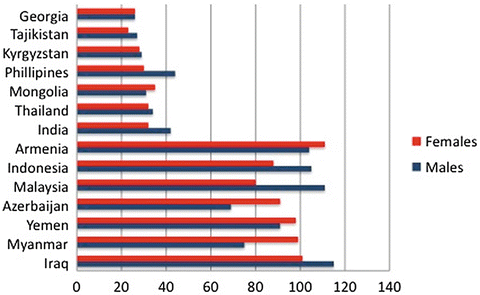

Fig. 2.6
Lowest and highest age-standardized mortality rates for all childhood cancers, LMIC from Asia (Source: GLOBOCAN 2008).
Trends in Childhood Cancer Mortality in LMIC from Asia
According to data available in the WHO Mortality Database, it is possible to assess trends in mortality for only four LMIC from Asia: Azerbaijan (1985–2007), Georgia (1994–2010), Kyrgyzstan (1985–2009), and Russia (1980–2010). In Azerbaijan, among males, a significant decrease in mortality was observed in the period 1985–1992 (APC = −8.4; 95 % CI −14.6; −1.6), followed by a nonsignificant increase in the period 1992–2007 (APC = 2.6; 95 % CI −0.3; 5.6), while a significant decrease was observed among females in the period 1985–2007 (AAPC = −4.5, 95 % CI −8.7; −0.2). In Georgia, no significant trends were observed in childhood cancer mortality for both males (APC = −0.4, 95 % CI −4.5; 3.8) and females (AAPC = 1.6, 95 % CI −7.9; 12.0). Important declines in childhood cancer mortality rates were observed for both males (APC = −3.7; 95 % CI −4.9; −2.4) and females (APC = −1.7; 95 % CI −3.0; −0.5) in Kyrgyzstan and also in Russia (males, AAPC = −2.1; 95 % CI −2.5; −1.7; females, AAPC = −1.7; 95 % CI −2.7; −0.7).
Childhood Cancer in LMIC from Latin America and the Caribbean
According to GLOBOCAN the estimated incidence of all pediatric cancers (0–14 years) in LMIC from Latin America and the Caribbean is 118 and 94/million for males and females, respectively. There is a wide variation in rates, with the highest ones being recorded in Guyana (171 million for males) and El Salvador (146/million among females), while the lowest incidence rates are observed in Haiti (16 and 12/million among males and females, respectively) (Fig. 2.7). Leukemia is the most frequent cancer type, corresponding to almost 39 % of all cancers diagnosed in children living in LMIC from Latin America and the Caribbean, followed by CNS tumors (13.4 %) and NHL (8.6 %) for both sexes (Fig. 2.8). Renal tumors are the fourth more frequent malignancy among children living in this region, with an annual incidence rate equal to 6 new cases/million. Testicular cancer appears on the list of most frequent cancers for the first time. Testes cancer is more likely in more highly developed countries in general; in this region, countries like Brazil and Mexico have economic conditions that approach those of HIC.
